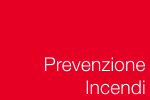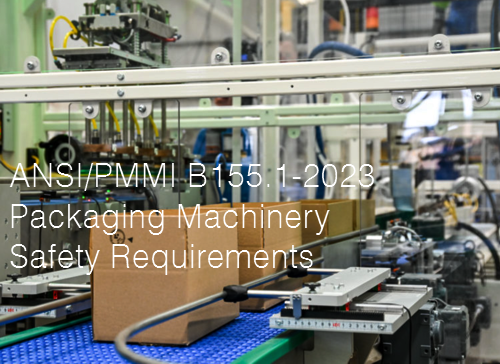ANSI/PMMI B155.1-2023: Packaging Machinery Safety Requirements
| ID 21510 | | Visite: 259 | News Normazione | Permalink: https://www.certifico.com/id/21510 |
ANSI/PMMI B155.1-2023: Packaging Machinery Safety Requirements
ID 21510 | 14.03.2024 / Download scheda
This standard specifies basic terminology, principles and a methodology for achieving safety in the design and the use of machinery. It specifies principles of the iterative process of risk assessment and risk reduction to help designers, integrators and users of machinery in achieving this objective.
These principles are based on knowledge and experience of the design, use, incidents, accidents and risks associated with machinery. Procedures are described for identifying hazards and estimating and evaluating risks during relevant phases of the machine lifecycle, and for the elimination of hazards or the provision of sufficient risk reduction. Guidance is given regarding the documentation of the risk assessment process.
Informative Note 1: As used in this standard, ‘machinery’ includes individual machines and machinery systems, for both packaging and processing machinery as defined in clause 3.
The requirements of this standard apply to new, modified or rebuilt industrial and commercial:
+ processing machinery used to produce food, beverage and pharmaceutical products;
+ machinery that performs packaging functions for primary, secondary, and tertiary packaging;
+ packaging converting machinery – machinery that converts glass, metal, paper, plastic or a combination of these into a package (e.g. cans, bottles, cups) or makes a package (e.g. bags, paperboard cartons, corrugated cases or trays) for subsequent use on a packaging machine; and
+ coordination of the packaging and processing functions that take place on the production line.
Informative Note 2: Primary packaging is the first wrap or containment of a product. Examples include a wrapped candy bar, a can containing liquid soup, a corrugated case containing a desk top printer, tablets in a bottle, vaccine in a vial, etc.
Informative Note 3: Secondary packaging is the packaging of product already in a primary package. Examples include case of soup cans, carton of 10 candy bars, bottled tablets / vial in a carton, etc.
Informative Note 4: Tertiary packaging is the packaging of a secondary package, often used for transport/distribution. Examples include stretch wrap pallet of cases of soup cans, a corrugated case filled with 24 cartons of candy bars, cartons of vials placed in a case, etc.
The standard does not include packaging or processing machinery used by retail consumers.
What Is Safe in ANSI/PMMI B155.1-2023?
According to ANSI/PMMI B155.1-2023: Safety Requirements For Packaging And Processing Machinery, safe is “the state of being protected from recognized hazards likely to cause serious physical harm.” Unfortunately, there is no such thing as being absolutely safe (i.e. being entirely free of all conceivable risks), especially in the case of machinery, which will always possess present hazards.
That being said, the operation of machinery, such as packaging machinery and packaging-related converting machinery used to produce food, beverage, and pharmaceutical products, is always a necessity. Therefore, the goal is not to eliminate all hazards but to mitigate them as much as possible in pursuit of a status that objectively can be deemed as safe. This is fulfilled through risk assessment and risk reduction for any group or individual affiliated with packaging machinery.
What Is ANSI/PMMI B155.1-2023?
The process for risk assessment is covered in the ANSI/PMMI B155.1-2023 standard, which was written and published by The Association for Packaging and Processing Technologies (PMMI), an ANSI-accredited standards-developing organization.
ANSI/PMMI B155.1-2023 covers the basic terminology, principles, and a methodology for achieving safety in the design and the use of machinery, and guidance is given for documenting this process. The iterative process of risk assessment and risk reduction specified in the standard helps designers, integrators, and users of machinery by providing them with principles based on knowledge and experience of the design, use, incidents, accidents and risks associated with machinery.
The requirements of this standard apply to new, modified, or rebuilt industrial and commercial: processing machinery used to produce food, beverage, and pharmaceutical products
- packaging machinery that performs packaging functions for primary, secondary, and tertiary
- packaging packaging converting machinery
- coordination of the packaging and processing functions that take place on the production line
Who Is Responsible for Packaging Machinery Risk?
Responsibility for risk management processes for packaging machinery is held by both the machinery suppliers and the users, who must define and achieve acceptable risk. While their responsibilities do differ, since the supplier is tasked with the design, construction, and information for operation and maintenance of the machinery, and the user’s duty lies solely with operation and maintenance, each party involved uses the same risk assessment process.
Since the risk assessment process should be identical for both the supplier and the user of the packaging machinery, there are many opportunities for collaborative efforts between the two groups. For example, the user is responsible for the installation or commissioning of the machinery, but they can acquire assistance from the manufacturer of that machinery through labels and guidance that simplify the assessment of risk that emerges during installation.
What Is the ANSI/PMMI B155.1-2023 Process?
As for the risk assessment process, an initial factor to consider is scalability to fit the particular organization and its culture. Variables related to this include the size or complexity of the project, location (conducted on or off site), formal (multi-discipline) vs. informal, cultural norms, and potential hazards related to product contamination.
The process itself is a series of logical steps used to systematically examine the hazards associated with the packaging machinery. The fundamentals of risk assessment are to identify hazards, assess risk, reduce risk to an acceptable level, and validate and document the results.
These ideas are reflected in the seven basic steps of the risk assessment process:
1. prepare for/set limits of the assessment
2. identify tasks and hazards
3. assess initial risk
4. reduce risk
5. assess residual risk
6. achieve acceptable risk
7. validate risk reduction measures
There are two main approaches to this process, as discussed in ANSI/PMMI B155.1-2023: hazard-based and task-based. Each of these is self-explanatory and specific to the needs of the organizations involved.
Ultimately, regardless of the approach used, risk assessment comes down to the fact that risk is a function of the severity of harm and the probability of occurrence of that harm. Due to this, risk must be appropriately scored for proper evaluation.
With this understanding of severity of the risk, along with the probability of its likelihood, users and suppliers are able to take measures necessary to control the hazards. Some potential measures are preferred, such as elimination or substitution of the component or process responsible for the hazards. Others, while not ideal for thoroughly mitigating the hazards, may also be selected, such as using personal protective equipment (e.g. safety glasses, earplugs, gloves). This decision is to be determined by the user or supplier. Where practical, hazards should be eliminated by design.
Like other management processes or systems in other industries, the risk assessment process should incorporate active leadership and competent persons to assure success.
What Are the Changes to ANSI/PMMI B155.1-2023?
ANSI/PMMI B155.1-2023 revises the 2016 edition of the same American National Standard.
Notable changes made to this standard include:
- Clarified text related to responsibilities of machinery suppliers, users, modifiers, purchasers of used machinery, and others
- Introduced concepts of co-packer / co-manufacturer and associated responsibilities
- Updated and clarified responsibilities for existing (legacy) machinery
- Included requirements for when whole body access applies
- Improved the information about validation
- Improved information related to remote / tele- operations of machinery
- Expanded requirements for radiation hazards and associated risk reduction measures
- New requirements for Heated Systems and Related Equipment for Processing of Materials
- Updated requirements for Information for use and manuals
- Reorganized clauses 4, “Responsibilities,” and 5, “Lifecycle requirements and responsibilities”
- Added and updated definitions
- Made clarifications to the Scope
- Updated/improved annexes
- Clarified content of Table D1 on estimating severity of harm
...
ANSI
Collegati
Sicurezza macchine per imballare EN 415-10
Sicurezza macchine imballaggio: Elenco norme serie EN 415
Tags: Normazione Norme ANSI










































